The UEFA Champions League group stage match between Borussia Dortmund and FC Barcelona at Signal Iduna Park was a great example of skill and strategy in action.
Barcelona won 3-2, taking a big step towards qualification for the knockout stages, as we will see in this tactical analysis.
After a pretty uneventful first half, the game really picked up in the final period.
Ferran Torres scored twice off the bench to give Barça their fifth straight League Phase win, moving them to second place in the standings with two games to go.
This analysis looks at the lineups, how the match progressed, and the tactics that made the difference.
Borussia Dortmund Vs Barcelona Lineup & Formation
With Nuri Şahin in charge, Borussia Dortmund went for a flexible 4-1-4-1 formation that changed into a 4-4-2 defensive structure during off-the-ball phases.
Gregor Kobel was in goal, with a defensive line comprising Ryerson, Can, Schlotterbeck and Bensebaini.
In midfield, Nmecha played a kind of hybrid role, supporting both defence and attack, while Reyna and Sabitzer aimed to provide some dynamism alongside the wingers Gittens and Duranville.
Guirassy was the focal point up front, using his physicality and movement to stretch Barcelona’s defence.
Barcelona, managed by Hansi Flick, responded with a 4-3-3 formation.
Iñaki Peña filled in as goalkeeper due to Marc-André ter Stegen’s injury.
Koundé and Baldé were the full-backs, with Cubarsí and Martínez as the centre-backs.
The midfield trio of Casadó, Pedri, and Dani Olmo were looking to control the ball and link up with the forward line, which included Raphinha, Lewandowski, and Lamine Yamal.
Clearly, Barcelona’s plan was to dominate possession, create overloads in midfield and rely on precise transitions.
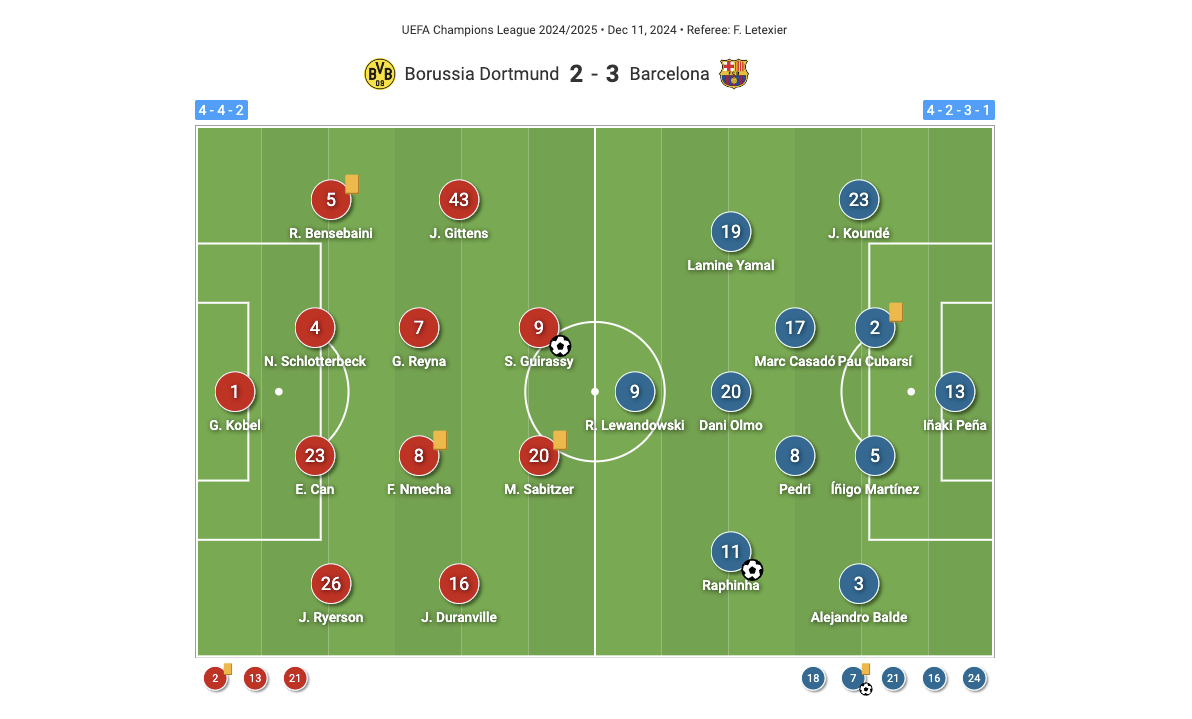
A Tactical Stalemate
The first 45 minutes were a tense, tactical battle, with the teams playing on a fairly level playing field.
Barcelona had the upper hand in terms of possession, holding the ball for long periods (54%) and relying on patient build-up play.
The Barcelona midfield trio worked hard to find gaps between Dortmund’s compact lines, but Dortmund’s disciplined defensive block stopped them in their tracks.
Pedri and Olmo did manage to find some gaps, but the final ball often lacked the sharpness needed to break down the hosts’ resolute backline.
Meanwhile, Dortmund were happy to give the ball away, retreating into a mid-block defensive structure.
They were quick to counter, exploiting Barcelona’s high defensive line by using the pace of their wide players and the physicality of Guirassy.
Nmecha was instrumental in disrupting the opposition’s play by reading the game well and intercepting passes to launch counter-attacks.
Guirassy was a real nuisance for Barcelona, testing the offside trap with some well-timed runs, but Barcelona’s defensive discipline held firm.
Dortmund’s Mid-Block
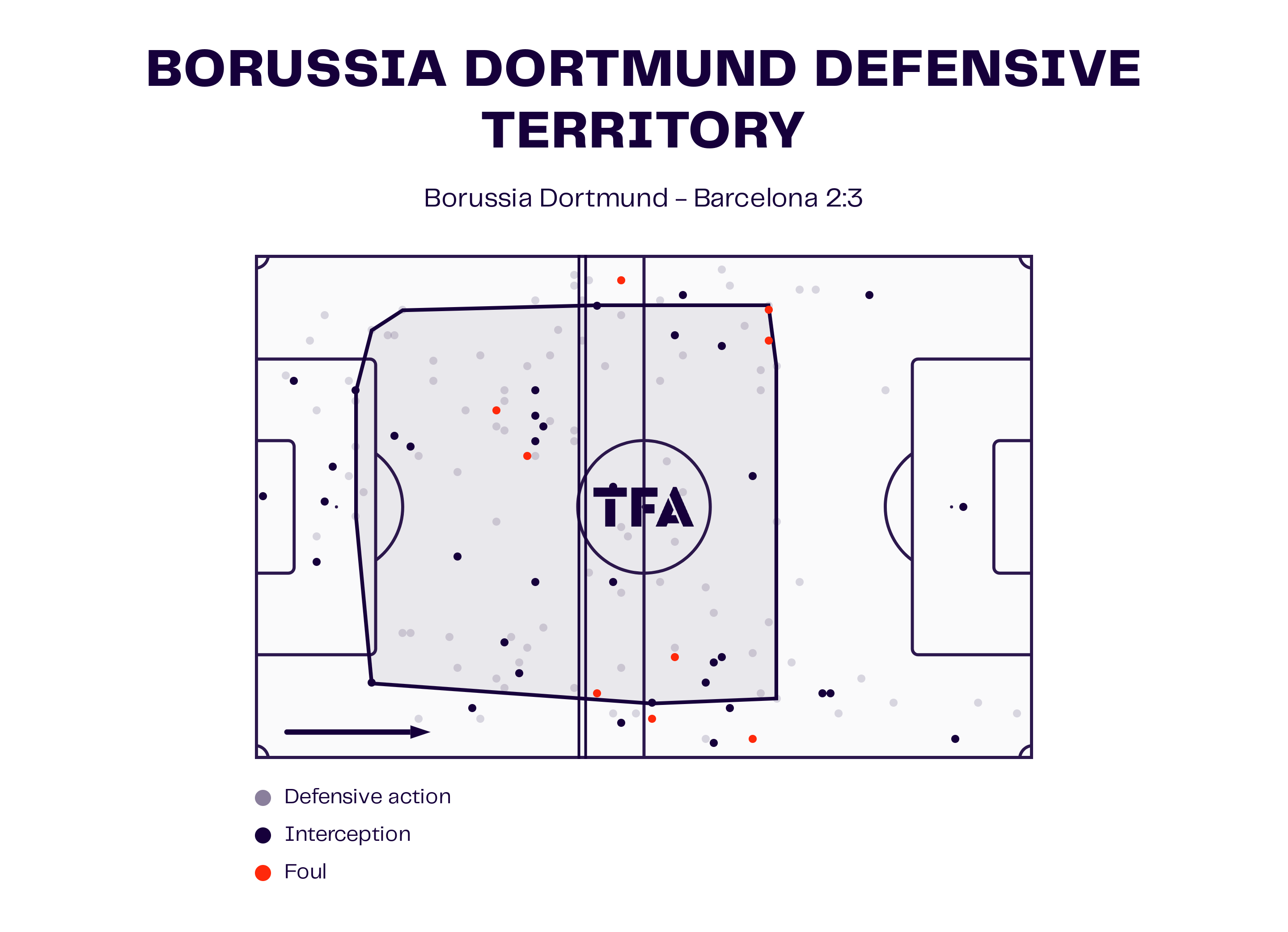
Both teams had opportunities to take the lead.
Dortmund had a promising opportunity when Duranville crossed to Guirassy, but the striker couldn’t make it count.
Barcelona had trouble creating clear-cut chances, as their attack often stalled in the final third.
The half ended with no goals, so both teams needed to make some changes to break the deadlock.
Tactical Shifts In Second Half
The second half got off to a faster pace, with both teams upping their game, and the game quickly got more exciting.
Barcelona got the first goal in the 48th minute, thanks to Raphinha, who got on the end of a perfectly weighted through ball from Dani Olmo.
The Brazilian sent a powerful strike into the bottom corner, giving the visitors the lead.
This goal showed how Barcelona can make the most of the moments when teams are changing their tactics.
Olmo spotted a gap in Dortmund’s defensive pressing and took advantage of it to create an opening.
Space In Midfield For Olmo
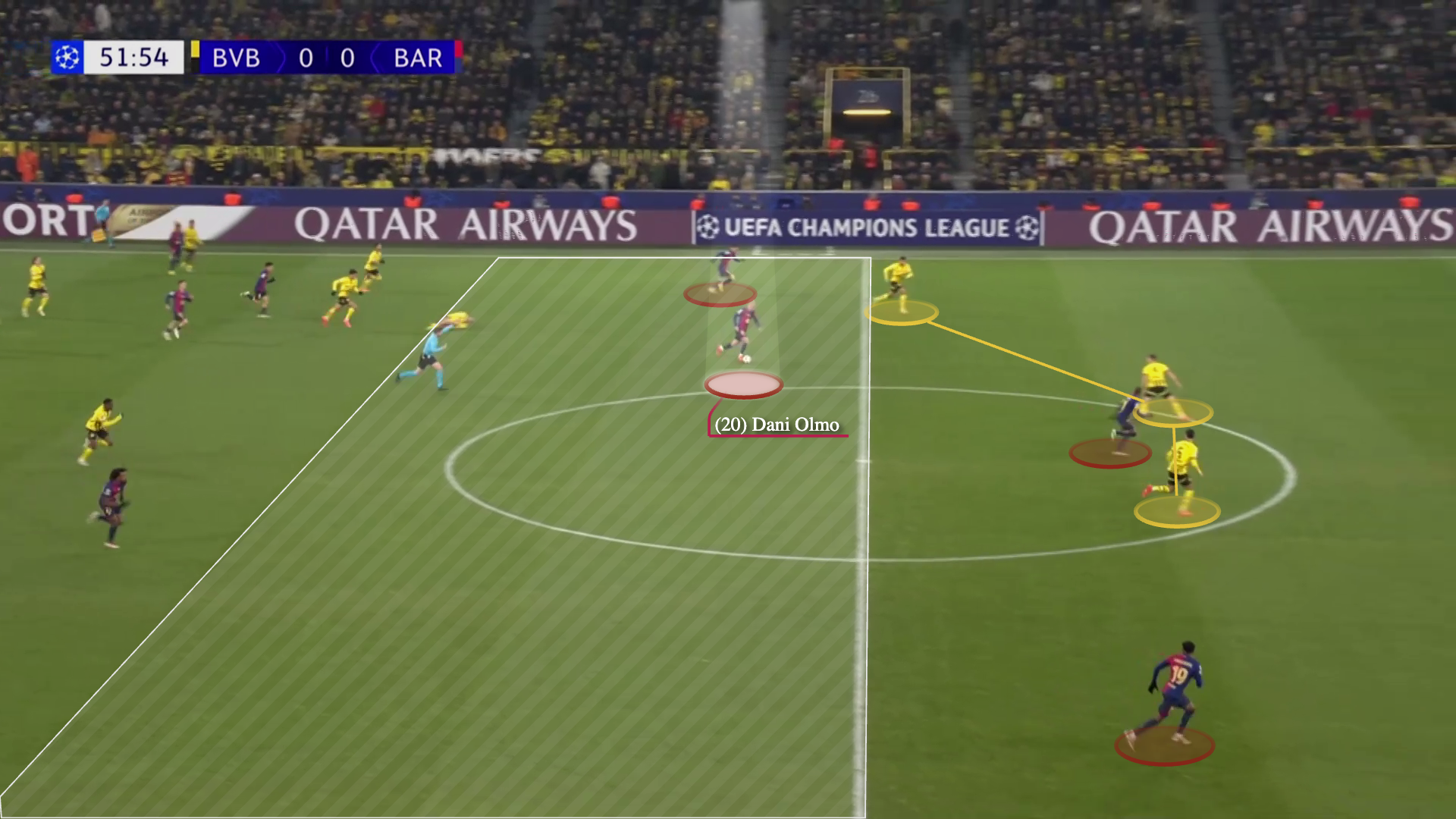
Dortmund responded quickly, with Pau Torres fouling Guirassy in the box, which resulted in a penalty.
Guirassy coolly converted, levelling the score at 1-1 and getting the Signal Iduna Park crowd going.
This equaliser prompted some changes in tactics from both managers.
Dortmund pushed higher up the pitch, while Barcelona tried to regain control of the midfield.
Borussia Dortmund High Regains Map
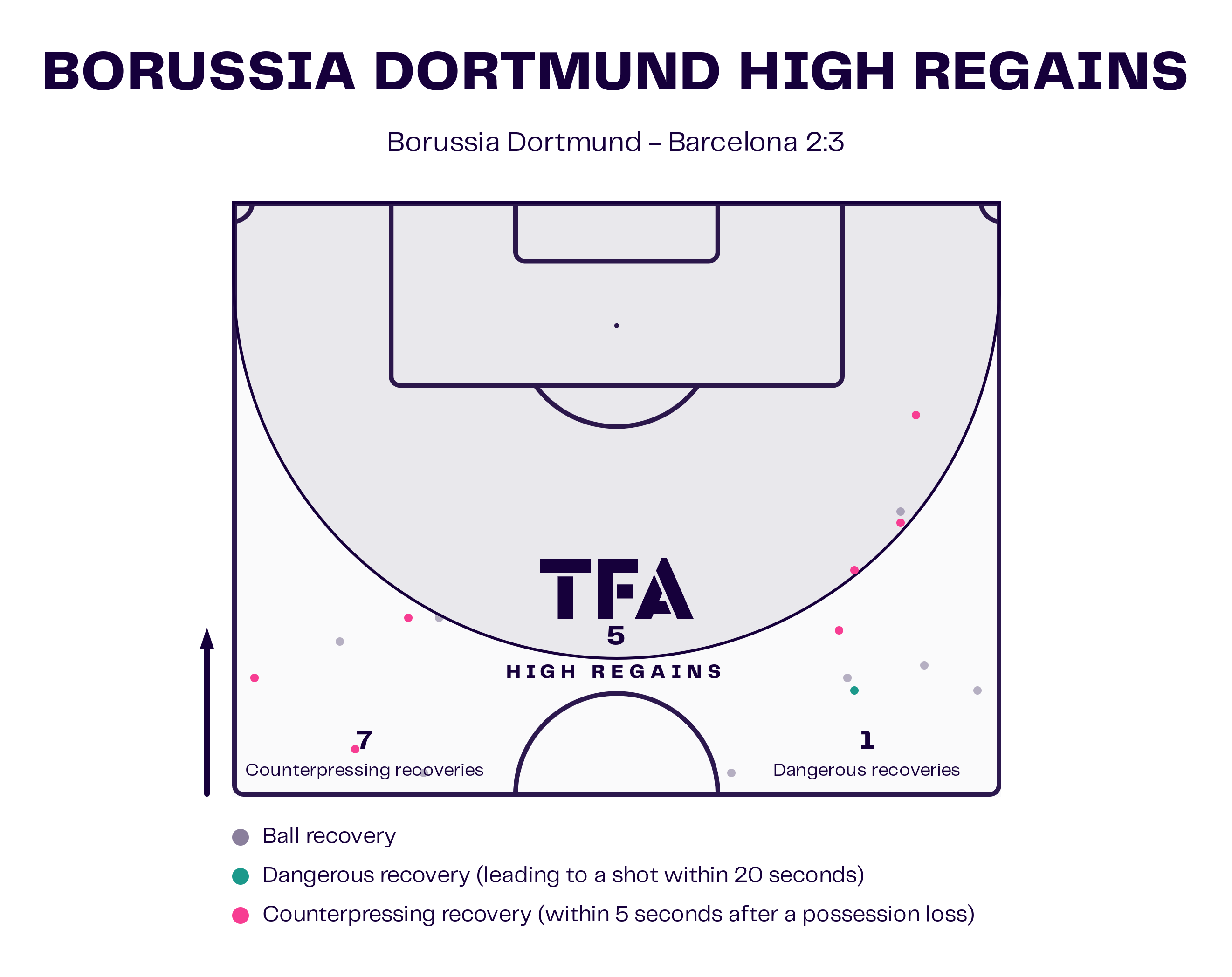
Hansi Flick’s substitutions in the 70th minute made all the difference.
He brought on Ferran Torres, Frenkie de Jong, and Fermín López for Lewandowski, Raphinha, and Olmo.
The new players gave Barcelona’s attack a boost, and within minutes, Torres was on the end of a rebound to restore their lead.
Dortmund, though, weren’t going to give up.
Yan Couto, who came on at half-time, delivered a perfect pass to Pascal Groß, who set up Guirassy for his second goal of the night.
The equaliser showed that Dortmund were resilient and could exploit Barcelona’s high line with well-timed runs and accurate passing.
Movement: Guirassy – Groß
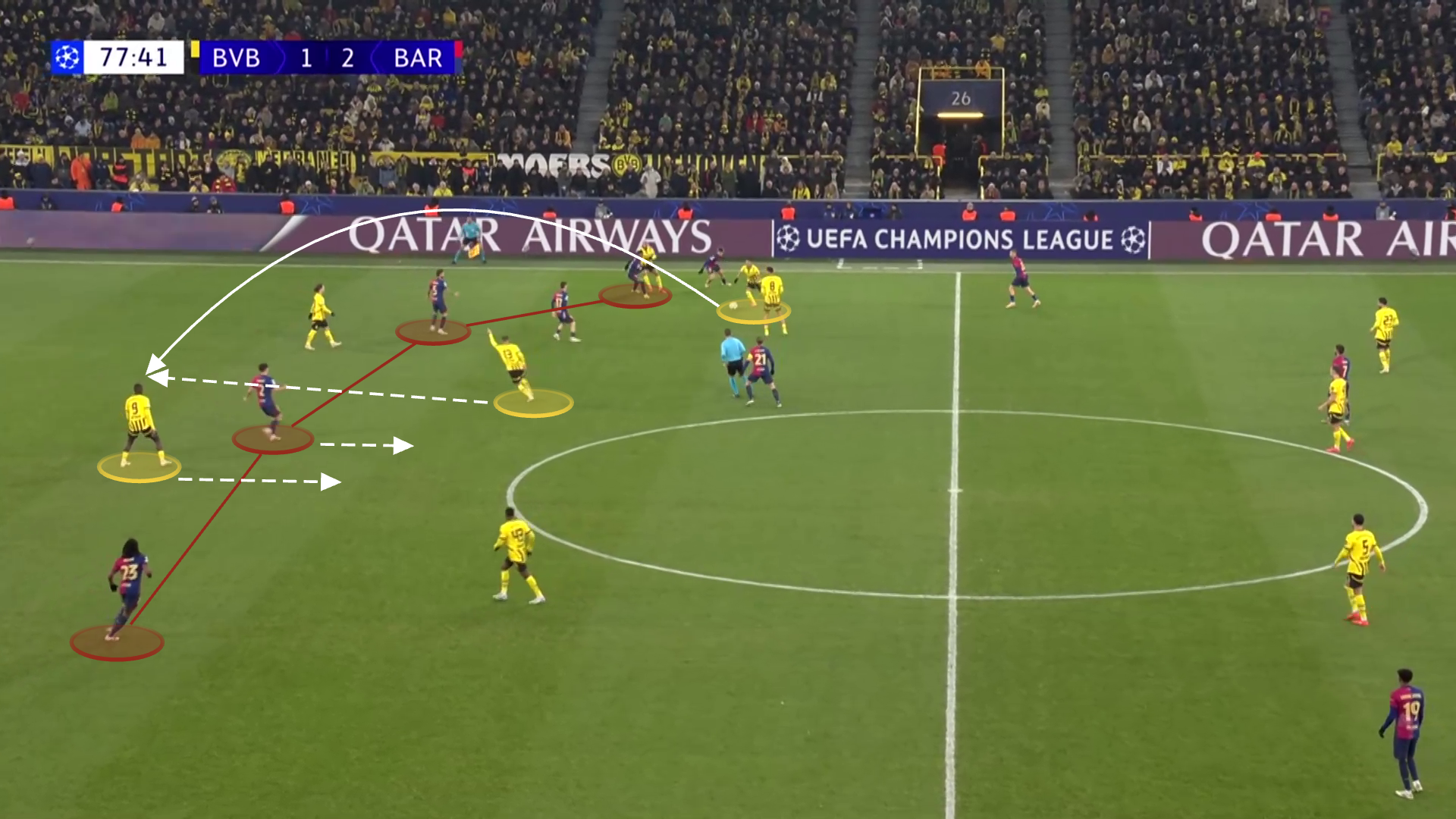
The game’s turning point came in the 85th minute when Barcelona launched a counter-attack from a Dortmund corner.
Lamine Yamal handled the ball with style and precision, passing it to Ferran Torres, who finished with a cool finish into the far corner to complete his brace.
This goal showed how well Barcelona played, using Dortmund’s weak defence to their advantage at a time when Dortmund were not playing as well as they could have done.
In the last few minutes of the game, Dortmund pushed forward in search of another equaliser.
A late free kick from Pascal Groß found Nico Schlotterbeck in a great position, but the defender’s header didn’t quite hit the target.
Barcelona held on for a hard-fought 3-2 victory, proving they can handle intense pressure and stick to their game plan even when things get tough.
Key Patterns
Dortmund’s defensive organisation and counter-attacking approach were key to their performance against Barcelona.
Dortmund used a hybrid 4-1-4-1 that shifted into a 4-4-2 during defensive phases.
This compact structure limited Barcelona’s ability to penetrate through the middle.
This shape meant the visitors had to rely on wide areas for progression, where the full-backs and wide midfielders were well-positioned to minimise crossing and shooting opportunities.
Nmecha’s hybrid role was really important.
He disrupted Barcelona’s rhythm as a midfielder and was a key outlet during transitions.
His defensive positioning allowed Dortmund to disrupt Barcelona’s rhythm.
Sabitzer often pressed high with Guirassy when the team switched to a 4-4-2 formation, creating a two-man press that targeted Barcelona’s centre-backs.
This approach occasionally disrupted Barcelona’s build-up, forcing them into lateral or backward passes.
Dortmund’s Pressing Structure
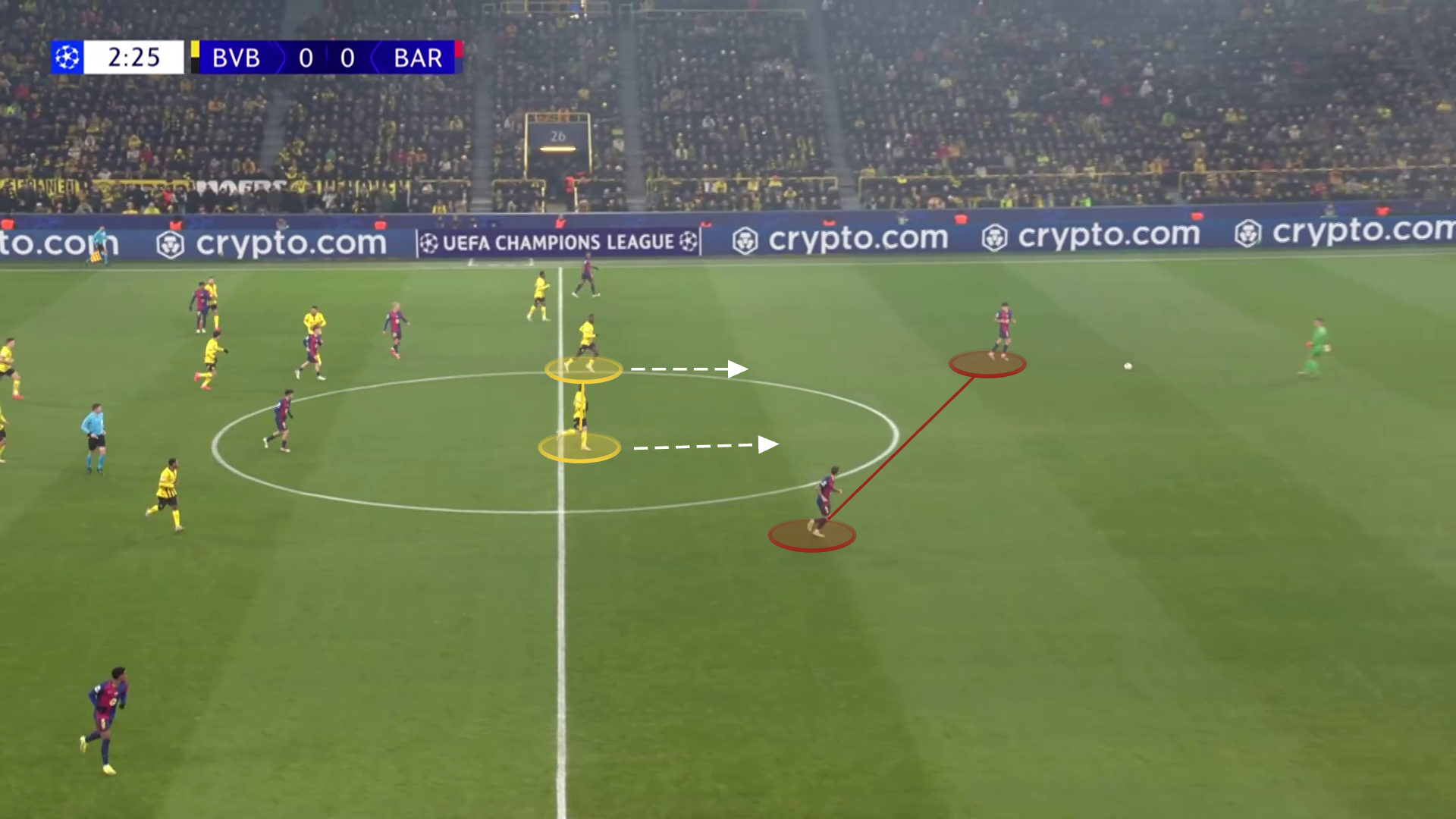
However, Dortmund’s pressing strategy did come with some inherent risks.
When Barcelona’s midfield trio, particularly Dani Olmo, managed to evade the press, they were able to exploit the gaps left by the advancing Dortmund players.
Olmo was smart about where he was on the pitch, which let him get the ball in dangerous areas.
He got around the press and helped Barcelona move the ball up the pitch quickly.
Barcelona’s high defensive line and aggressive offside trap had two sides to them.
While the trap was effective in stopping several Dortmund attacks – most notably Guirassy’s disallowed tap-in early in the second half – it relied on precise coordination among the backline.
This tactic made it tricky for Dortmund to get behind the defence in open play, but it was easy to get past it with well-executed through balls and runs from deep.
Yan Couto’s introduction at half-time meant that Dortmund were able to exploit this vulnerability.
His ability to deliver precise passes in transition, including the assist for Dortmund’s second goal, showed how Barcelona’s trap could be bypassed.
Couto’s vision and timing showed where there were gaps in Barcelona’s defensive line, creating opportunities for Guirassy and others to take advantage.
Hansi Flick’s substitutions were a big reason why Barcelona won.
In the 70th minute, Ferran Torres, Frenkie de Jong, and Fermín López were brought on, giving the team a boost of energy and dynamism.
Torres’ movement without the ball made it harder for Dortmund to defend, giving his teammates more space and creating more chances for goals.
Torres’ first goal showed he’s got the composure and instinctive finishing skills.
He was in the perfect position to make the most of a rebound, which showed just how strong Barcelona’s attack is.
His second goal, which came from a quick counterattack, showed he can make important plays when the team is on the move.
This adaptability and finishing quality showed just how versatile Barcelona’s attack could be.
Ferran Torres Shot Map
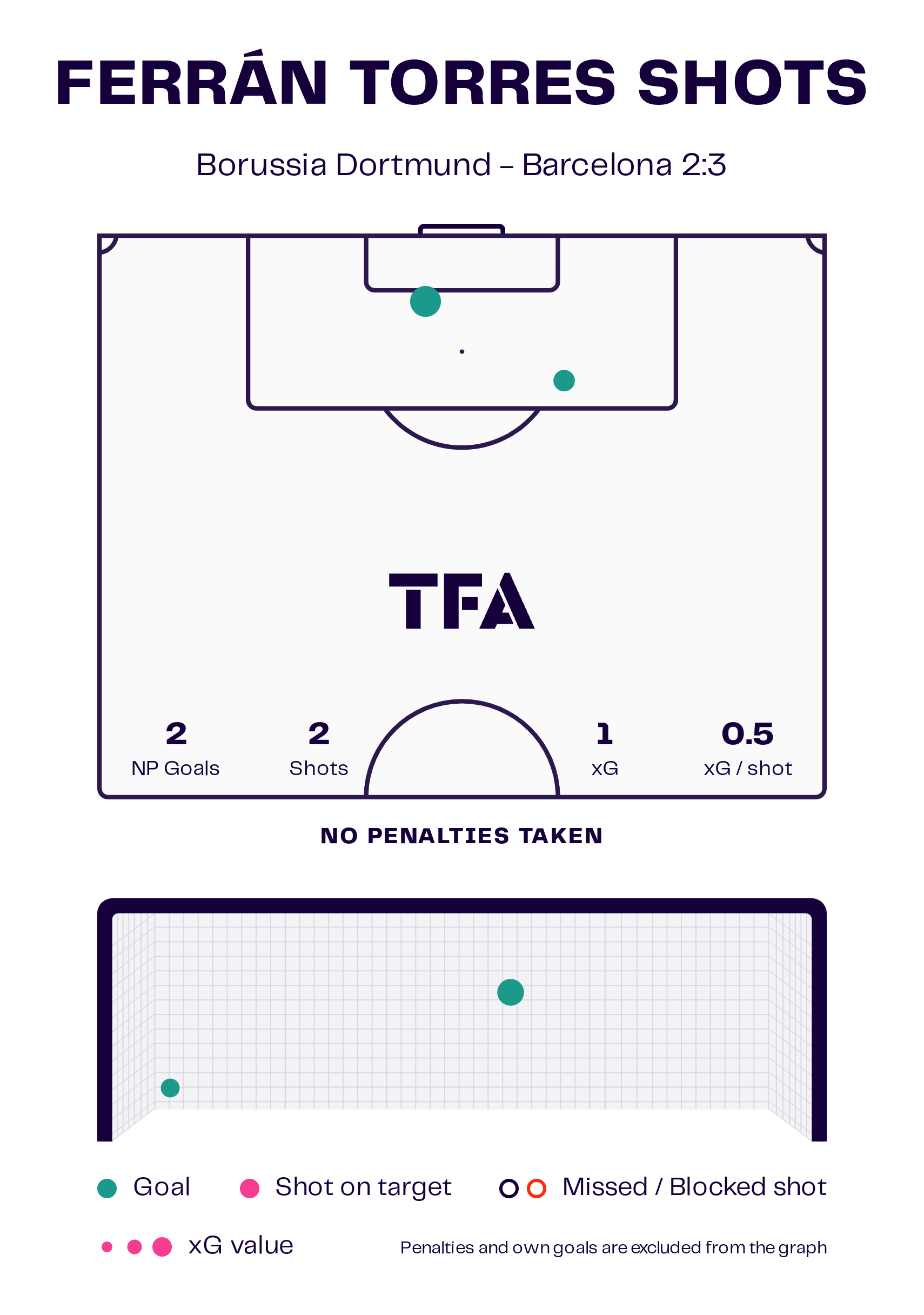
The midfield was a key area of focus throughout the match.
Olmo was instrumental in Barcelona’s approach, finding spaces and dictating play.
His movement and passing kept Dortmund’s defence on their toes, particularly in the first half, where he kept positioning himself between Dortmund’s midfield and defensive lines.
Dortmund made some changes in the second half, moving Reyna closer to Nmecha to create a more compact midfield.
This change helped them keep Barcelona from building up their attacks better because Reyna’s pressing worked well with Nmecha’s defensive efforts.
However, this wasn’t enough to stop Barcelona’s midfield trio in their tracks.
Pedri and Olmo kept on finding ways to exploit gaps, particularly during transitions.
Conclusion
Dortmund’s defensive solidity and quick transitions showed they had a good strategy and could adapt to different situations.
However, there were times when Barcelona’s technically gifted midfielders were able to exploit the occasional vulnerability in Dortmund’s pressing structure.
Barcelona’s aggressive offside trap showed they were confident but also highlighted the risks of such a high-risk defensive approach.
In the end, Barcelona’s superior efficiency in the final third and the impactful substitutions made by Flick were the deciding factors.
Dortmund showed resilience and tactical smarts, but Barcelona adapted well and made the most of key moments, securing a 3-2 victory.
This match was a great example of how tactics and individual quality can make a real impact.
Both teams can learn a lot from this match as they continue in the UEFA Champions League.

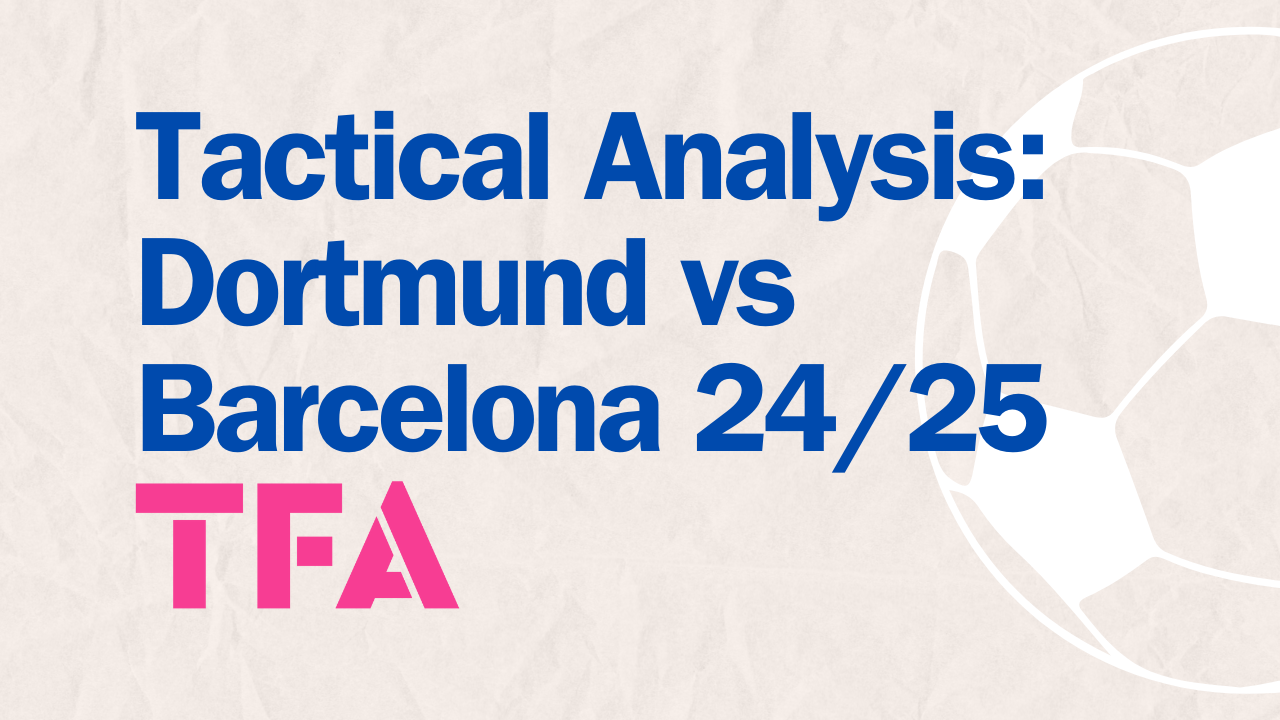



Comments